
Sicily is the largest and most populous island in the Mediterranean Sea and one of the 20 regions of Italy with the Strait of Messina dividing it from the region of Calabria in Southern Italy. It is one of the five Italian autonomous regions and is officially referred to as Regione Siciliana. The region has 4.8 million inhabitants. Its capital city is Palermo.

Trapani is a city and municipality (comune) on the west coast of Sicily, in Italy. It is the capital of the Province of Trapani. Founded by Elymians, the city is still an important fishing port and the main gateway to the nearby Egadi Islands.

Erice is a historic town and comune in the province of Trapani, Sicily, in southern Italy. It is a member of the I Borghi più belli d'Italia association.

Marsala is an Italian town located in the Province of Trapani in the westernmost part of Sicily. Marsala is the most populated town in its province and the fifth in Sicily.

Abruzzo, historically known as Abruzzi, is a region of Southern Italy with an area of 10,763 square km and a population of 1.3 million. It is divided into four provinces: L'Aquila, Teramo, Pescara, and Chieti. Its western border lies 80 km (50 mi) east of Rome. Abruzzo borders the region of Marche to the north, Lazio to the west and north-west, Molise to the south and the Adriatic Sea to the east. Geographically, Abruzzo is divided into a mountainous area in the west, which includes the highest massifs of the Apennines, such as the Gran Sasso d'Italia and the Maiella, and a coastal area in the east with beaches on the Adriatic Sea.

Tourism in Italy is one of the economic sectors of the country. With 65 million tourists per year (2019) according to ISTAT, Italy is the fifth most visited country in international tourism arrivals. According to 2018 estimates by the Bank of Italy, the tourism sector directly generates more than five percent of the national GDP and represents over six percent of the employed.

Trapani is a province in the autonomous island region of Sicily, southern Italy. Following the suppression of the Sicilian provinces, it was replaced in 2015 by the Free municipal consortium of Trapani. Its capital is the city of Trapani. It has an area of 2,469.62 square kilometres (953.53 sq mi) and a total population of 433,826 (2017). There are 25 comunes in the province.
The Music of Sicily refers to music created by peoples from the isle of Sicily. It was shaped by the island's history, from the island's great presence as part of Magna Grecia 2,500 years ago, through various historical incarnations as a part of the Roman Empire, then as an independent state as the Emirate of Sicily then as an integral part of the Kingdom of Sicily and later the Kingdom of the Two Sicilies, and, finally, as an autonomous region of the modern nation state of Italy.

Favignana is a comune including three islands of the Aegadian Islands, southern Italy. It is situated approximately 18 kilometres west of the coast of Sicily, between Trapani and Marsala, the coastal area where the Stagnone Lagoon and the international airport of Trapani, are sited.
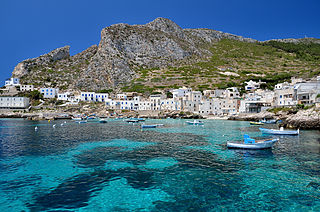
Levanzo is the smallest of the three main Aegadian Islands in the Mediterranean Sea west of Sicily, Italy. It forms a part of the municipality (comune) of Favignana in the Province of Trapani.

The Necropolis of Pantalica is a collection of cemeteries with rock-cut chamber tombs in southeast Sicily, Italy. Dating from the 13th to the 7th centuries BC, there was thought to be over 5,000 tombs, although the most recent estimate suggests a figure of just under 4,000. They extend around the flanks of a large promontory located at the junction of the Anapo river with its tributary, the Calcinara, about 23 km (14 mi) northwest of Syracuse. Together with the city of Syracuse, Pantalica was listed as a UNESCO World Heritage Site in 2005.
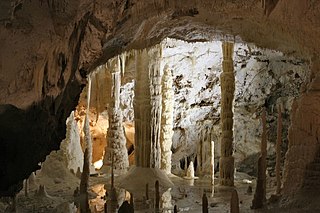
The Frasassi Caves are a karst cave system in the municipality of Genga, Italy, in the province of Ancona, Marche. They are among the most famous show caves in Italy.
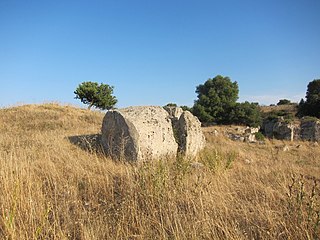
Cave di Cusa or Rocche di Cusa was an ancient stone quarry in Sicily. It is located 3 kilometers south of the town Campobello di Mazara in the province of Trapani, Italy. It is 1.8 kilometer long and is on a ridge that spans from east to west. This site was quarried beginning in the first half of the 6th century BC and its stone was used to construct the temples in the ancient Greek city Selinunte. It was abandoned in 409 BC when the city was captured by the Carthaginians. It is now an official Sicilian Archeological Zone and a popular tourist site.

The Addaura cave is a complex of three natural grottoes located on the northeast side of Mount Pellegrino in Palermo, Sicily, Southern Italy. The importance of the complex is due to the presence of cave-wall engravings dated to the late Epigravettian and the Mesolithic.

Addaura is a seaside village or Frazione of Palermo, Italy included in the VII District. It resides on the Lungomare Cristoforo Colombo, which starts from the south-east border of Mondello and reaches Palermo bypassing Monte Pellegrino.
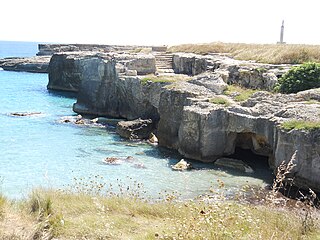
Roca is an archaeological site located on the Adriatic coast of Apulia in Southern Italy, a few kilometres from the modern town of Melendugno and close to the city of Lecce. The site, which has been explored since the end of the 1980s by a team of the University of Salento, has produced some of the best-preserved monumental architecture of the Bronze Age in Southern Italy, along with the largest set of Mycenaean pottery ever recovered west of mainland Greece.

The Roman furnaces in Alcamo are part of the archaeological complex of Alcamo Marina and were discovered in 2000.

Monte Erice, or ancient Greek Mount Eryx, is a mountain of Sicily, in the province of Trapani.
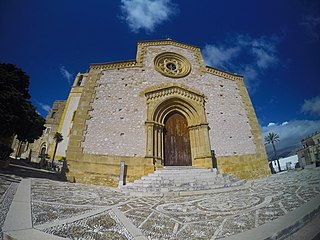
The Sanctuary of Maria Santissima di Custonaci is a Catholic Church located in the town centre of Custonaci dedicated to Mary. Madonna of Custonaci is the patroness and guardian of the communes of agro Erice.

The Archaeological site of Mount Bonifato is located in Alcamo, in the province of Trapani, in Sicily.



















